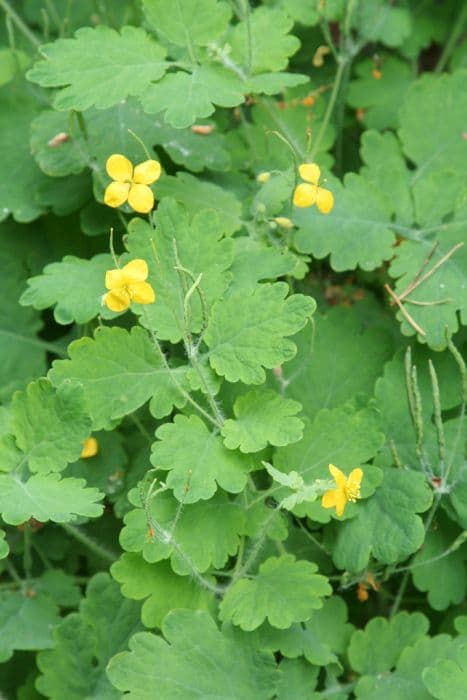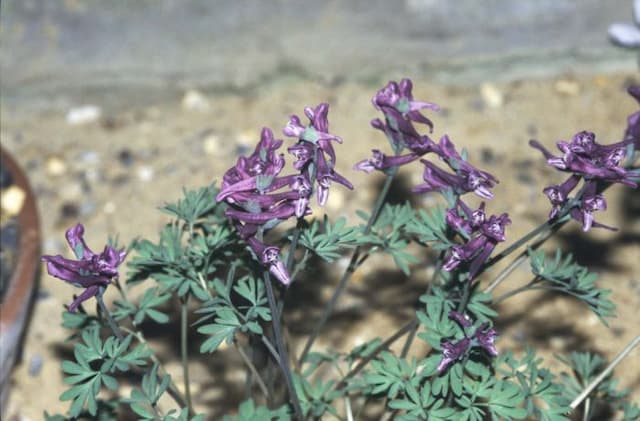Opium poppy Papaver somniferum

ABOUT
The plant known most commonly as the opium poppy is characterized by its distinctive features that contribute to its recognizable appearance. The opium poppy has a set of lobed, toothed leaves that are usually a grayish-green hue. These leaves are spread out around the base of the stem and along it, spiraling up in an alternating pattern. The stem is topped with large, showy flowers that can come in various colors such as white, pink, purple, and red, often with a darker base. At the centre of the flower, there is a conspicuous, round seed pod, which swells after the petals fall. These pods are initially green and gradually turn brown as they mature. The flowers have a silky texture and are comprised of four to six petals that are typically crinkly or papery to the touch. Surrounding the center of the flower are numerous dark-purple or black stamens which contrast the petals. After the blooming period, the petals drop to reveal the seed pod, which is filled with small, slate-blue seeds that are commonly used in baking and cooking.
About this plant
 Names
NamesFamily
Papaveraceae.
Synonyms
Opium Poppy, Breadseed Poppy, White Poppy, Garden Poppy.
Common names
Papaver somniferum var. album, Papaver somniferum var. nigrum, Papaver somniferum var. hortense, Papaver somniferum var. paeoniflorum, Papaver somniferum var. setigerum, Papaver setigerum, Papaver somniferum var. glabrum, Papaver somniferum var. pilosum, Papaver somniferum var. scabrum.
 Toxicity
ToxicityTo humans
The most common common name for Papaver somniferum is the opium poppy. The opium poppy is known for containing naturally occurring opiate alkaloids including morphine, codeine, and thebaine, which are toxic when consumed in significant quantities. If ingested, these substances can cause symptoms such as drowsiness, lethargy, respiratory depression, nausea, vomiting, constipation, and confusion. Overdose can lead to severe respiratory depression, which can be fatal. Due to the presence of these alkaloids, particular care should be taken to avoid consuming any parts of the plant.
To pets
The opium poppy is also toxic to pets. The alkaloid content, including morphine and codeine, can affect the central nervous system, causing symptoms similar to those seen in humans, such as sedation, incoordination, and slowed breathing. In severe cases, ingestion can lead to respiratory failure and death. It is important to prevent pets from consuming any part of the plant due to these risks.
 Characteristics
CharacteristicsLife cycle
Annuals
Foliage type
Deciduous
Color of leaves
Green
Flower color
Varies
Height
2-4 feet (60-120 cm)
Spread
1-2 feet (30-60 cm)
Plant type
Herb
Hardiness zones
7
Native area
Mediterranean
Benefits
 General Benefits
General Benefits- Culinary uses: The seeds of Papaver somniferum, commonly known as the opium poppy, are edible and often used as a spice or decoration in baked goods such as breads, cakes, and rolls.
- Agricultural uses: Opium poppy seeds are pressed to extract poppy seed oil, which is used for culinary purposes and sometimes as lamp fuel or in paint making.
- Bee attraction: The flowers can attract bees and other pollinators, which is beneficial for the garden ecosystem and helps in the pollination of nearby plants.
- Landscape aesthetics: With their showy flowers and striking appearance, opium poppies are often planted for ornamental purposes, adding color and vibrancy to gardens and landscapes.
- Soil improvement: Like many other plants, poppies can help maintain soil health and prevent erosion by establishing root systems that stabilize the soil.
 Medical Properties
Medical Properties- Analgesic: Papaver somniferum, commonly known as the opium poppy, contains alkaloids such as morphine, which are powerful pain relievers.
- Sedative: Its derivatives have sedative effects that can induce sleep and reduce anxiety.
- Cough suppressant: Codeine, another alkaloid derived from the opium poppy, is commonly used in cough medications.
- Antidiarrheal: The plant's alkaloids, like morphine, can decrease gastrointestinal motility and are used in treating diarrhea.
- Anesthetic: Some derivatives can be used as anesthetics in medical settings.
- Spasmolytic: It has antispasmodic properties that are helpful in relieving muscular spasms.
 Air-purifying Qualities
Air-purifying QualitiesThis plant is not specifically known for air purifying qualities.
 Other Uses
Other Uses- Ornamental Gardening: Papaver somniferum, commonly known as the opium poppy, is often grown for its large, showy flowers which can add vibrant colors and aesthetic appeal to gardens and landscapes.
- Culinary Coloring: The petals of the opium poppy can be used to create a natural red dye for coloring foods and pastries, providing an alternative to artificial food colorings.
- Soap Making: The opium poppy seeds contain oil that can be used in the production of soaps, offering a moisturizing quality and a gentle exfoliating texture from the crushed seeds.
- Photography: Due to its distinct appearance, the opium poppy is sometimes used in macro and close-up photography as a subject to showcase the intricate details of its petals and structure.
- Eco-Friendly Ink: The pigments obtained from opium poppy petals can be processed to make eco-friendly inks for art and craft activities, embracing sustainable practices.
- Floral Arrangements: Dried opium poppy pods are commonly used in floral arrangements, wreaths, and bouquets for their interesting shapes and textures.
- Textile Dyeing: The natural pigments found in the opium poppy are also used in dyeing textiles, giving fabrics a unique and natural color without the use of synthetic dyes.
- Paper Making: The seed pods and stems of the opium poppy, when dried and processed, can be incorporated into handmade papers for a decorative touch.
- Biodegradable Mulch: Crushed seed pods and plant residue from the opium poppy can be used as a biodegradable mulch in gardens, providing nutrients to soil as they decompose.
- Jewelry Making: Small opium poppy seed pods are sometimes used in jewelry making, providing an organic and natural element to the craft.
Interesting Facts
 Feng Shui
Feng ShuiThe opium poppy is not used in Feng Shui practice.
 Zodiac Sign Compitability
Zodiac Sign CompitabilityThe opium poppy is not used in astrology practice.
 Plant Symbolism
Plant Symbolism- Peace: Associated with sleep and death in various cultures, Papaver somniferum, commonly known as the opium poppy, symbolizes rest and eternal peace.
- Morpheus' embrace: In Greek mythology, Morpheus is the god of dreams. The opium poppy's narcotic properties link it to the idea of being embraced by sleep and dreams.
- Remembrance: Opium poppies have become symbols of remembrance, especially for fallen soldiers, due to their proliferation on European battlefields after World War I.
- Beauty and Resilience: Despite the delicate appearance of their petals, opium poppies exemplify beauty and resilience as they can thrive in disturbed soil where other plants cannot.
- Escape from Sorrow: The opium derived from Papaver somniferum has been used historically to alleviate pain and suffering, symbolizing an escape from grief or hardship.
- Riches and Success: The economic value of opium historically made it a symbol of wealth and success in parts of the world where it was traded.
- Temporary Pleasure: The fleeting bloom of the poppy and the short-lived high from its opium yield symbolize the transient nature of pleasure.
 Water
WaterThe opium poppy requires watering once a week, with about 1 inch of water to ensure the soil is moist but not waterlogged. During the hot summer months, it may need watering twice a week. It is important to not overwater as it may lead to root rot. When watering, aim for the base of the plant and try to avoid wetting the foliage. If you are growing opium poppies in containers, they may require more frequent watering, possibly every other day, with several gallons per week depending on the size of the pot and environmental conditions.
 Light
LightOpium poppy thrives in full sunlight and should be planted in a spot where it can receive at least 6 hours of direct sun daily. They perform best in a location that offers morning sunlight and some shelter from the intense afternoon sun, although they can tolerate full sun conditions throughout the day.
 Temperature
TemperatureOpium poppies favor temperate climates with ideal growth temperatures ranging between 50-75°F. They can survive minimum temperatures down to 30°F and maximum temperatures of about 90°F, but prolonged exposure to these extremes can be detrimental to the plant. It is important to protect the opium poppy from frost, which can damage or kill the plant.
 Pruning
PruningPruning opium poppies is not generally necessary, but deadheading spent flowers can encourage a second bloom. Prune back to the base of the stem just above a set of leaves or a branching point. The best time to prune is after the first flowering, usually in mid to late summer, to promote a second wave of blooms before fall.
 Cleaning
CleaningAs needed
 Soil
SoilOpium poppy prefers well-draining soil with a neutral to slightly alkaline pH, around 7.0 to 7.5. A good mix may contain equal parts of loam, sand, and compost to ensure nutritional balance and drainage.
 Repotting
RepottingOpium poppy is generally not repotted as it's an annual plant, meaning it completes its life cycle in one growing season and does not require repotting.
 Humidity & Misting
Humidity & MistingOpium poppy thrives in average humidity levels; it does not require special humidity conditions and can grow in the humidity levels found in typical outdoor environments.
 Suitable locations
Suitable locationsIndoor
Ensure full sun, well-draining soil, and a spacious pot for indoor growth.
Outdoor
Plant in full sun, well-drained soil, and space seedlings properly.
Hardiness zone
7-10 USDA
 Life cycle
Life cycleThe life of Papaver somniferum, commonly known as opium poppy, begins with seed germination, which requires a period of cold stratification to break dormancy. Once the environmental conditions are right, usually in spring, the seed germinates and the plant starts its growth as a seedling, developing a rosette of leaves near the soil surface. As the plant matures, it elongates its stem, producing a solitary flower bud that develops at the top of the stem. The bud blooms into a large flower, typically with petals ranging from white to purple and a central ovary. After pollination, usually by insects, the flower fades and the ovary swells to form a seed capsule containing numerous tiny seeds. The plant completes its life cycle when it withers after seed maturation and dispersal, which can occur through wind, water, or mechanical means, and may lie dormant until the next appropriate growth season.
 Propogation
PropogationPropogation time
Spring-Early Summer
Propogation: Papaver somniferum, commonly known as the opium poppy, is most commonly propagated through seed. The ideal time to sow opium poppy seeds directly into the soil is in early spring, as soon as the ground can be worked, but after the last frost to avoid seed damage. Sowing should be done thinly, as the plants will need room to grow, and those seedlings that emerge too closely together will eventually need thinning. The seeds are very small; hence, they should be mixed with sand for even distribution and lightly covered with soil. Regular watering should be provided until germination occurs, which typically takes 7 to 14 days. Seeds can also be started indoors 4-6 weeks before the last frost date, but they are sensitive to disturbance from transplanting, making direct seeding the preferred method.









